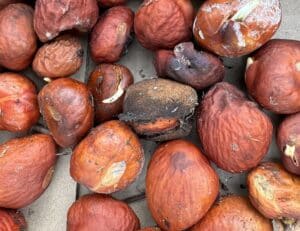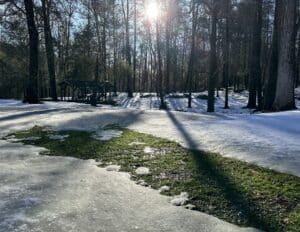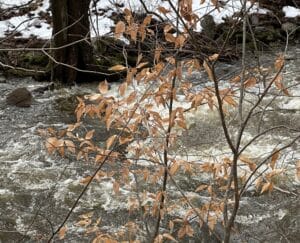Hello, fellow lovers of all things green,
Once again, I was late tending to my garden, scurrying about just before the first snow. You’ve likely heard the phrase “a shoemaker without shoes.” It’s ironic how folks who provide a service often neglect to provide it for themselves. But one of the treasures of a fall garden clean up in early winter is coming upon seeds from the Bottlebrush Buckeye that dropped to the ground. I’m sure they’ve done so yearly (I’ve had the plants for over ten years) and never noticed. Aesculus parviflora is one of my favorite native transition shrubs between woodlands and lawns, reaching 8 to 12 feet high and wide in zones 4 to 8 in full shade to full sun. And A-rated in deer resistance, to boot!

Bottlebrush Buckeye (Aesculus parviflora) in its summer glory.
Sowing the Treasures of Bottlebrush Buckeye Seeds
The tough leather-like capsules that cover the smooth brown seeds were shed, and some of the taproots started to emerge, looking like tiny white fingers. Two were deeply rooted, sitting around their parent plants on the soil’s surface. I let them be. Then I grabbed the others to disperse around the property, where I would love more waves of texture with its hefty leaves and lovely mounding shape. Plus, the feathery white flowers in summer that look like bottle brushes will attract bees, butterflies, and hummingbirds.

Bottlebrush Buckeye Seeds
As the flurries began to fall, I dug in the Bottlebrush Buckeye seeds, planting them only one to two inches deep, about eight feet apart. I planted some near our boggy area in the higher regions that aren’t always saturated, as the flexible fellow prefers well-drained, moist soil but tolerates flooding and moderate drought. And I dug others along the woodland edge near the feeder to the pond.
Beyond propagating by seed, Bottlebrush Buckeye colonizes by suckering. Shoots come from the roots or stems of the plant. Then, the shoots put out roots to form a new plant, genetically identical to their mother plant. You can move the babies by carefully cutting them away from the parent plant and transplanting them. Preferably, do that in early spring before the bud break or late fall when it’s dormant. But before the snow. I’m just saying. (smile)

A river of green amongst the early winter meltdown.
Embrace the Early Winter Treasures in Nature
Looking around at nature’s landscape after the meltdown, I marvel over the swath of lime-green grass near the vegetable garden where the underground spring runs through, with remnants of snow and slush on each side.
On the morning walk, passing Jacksonburg Creek, which runs through our front yard, turned into a rushing river with racing currents. In front of it, a healthy young beach tree, unaffected by Beech Leaf Disease, with many tawny tan leaves still intact, dancing in the wind. The sky was blue and then grew overcast, and spritzes of frozen raindrops, almost sleet, tickled my face from above.

A Young Beech Tree in front of Jacksonburg Creek.
On the return trip, I gathered remnants of cedar trees knocked off from the snowplow, reminding me of the story of decorating with “roadkill” long ago. I didn’t dress the window boxes for winter yet (there was no roadkill until the snow), so now I have the treasures from the side of the road. I wondered why cedar trees rooted themselves where the hemlock stood. It occurs to me they are from the previous pilfering of roadside treasures, spreading the seeds of life.
The cycle of nature, the infinity of life.
Moving tree remnants, including berries, to areas other than where nature intended may be considered tampering. But consider yourself a bird or a mammal (humans are, after all) and how wildlife transports seeds from place to place. It is part of the cycle of nature, the infinity of life.
In the winter months, cherish all the beautiful treasures around you, including family and friends, as we spend more time near home. Maybe gather some of your belongings you no longer or rarely use and pass them on to someone who needs or will enjoy them. As you clear your spaces, perhaps give one of your most treasured things to someone you cherish. You’ll see how good it feels.
We come into this world with nothing (no things) and leave with no things, but we leave behind the love we give. It’s the circle of life that never ends.
Garden Dilemmas? AskMaryStone@gmail.com and your favorite Podcast App.
There’s more to the story in the 10-Minute Garden Dilemmas Podcast:
Related Stories (and Episodes) and Helpful Links:
Bottlebrush Buckeye Hide Tree Knees featured in Ep 118
We’re All Just Seeds featured in Ep11. The Promise of Seeds



The Buckeye is so interesting!! And such a cool plant! Likes shade, flowers, attracts all my favorite yard visitors AND repels deer?!! I apparently need a bigger yard……
I cherish winter too! So many of my family and peers are leaving NJ for destinations south, but I don’t see it. I love this time to turn inward. To hibernate, rest and regenerate energy. To sort closets and clean drawers. To take stock of what still suits me and what needs to be passed along. And I especially love nature enforced days of rest, when it snows and things get cancelled and we stay home. Humans are the only creatures that strive to control our environments the way we do with artificial light and 4 wheel drive vehicles. All other creatures in the plant and animal world know how to embrace winter. I will say though that I find the weeks from St Pat’s Day to May 15, when we can finally plant annuals tiresome. It’s not winter, but it’s not really time for gardens. I find myself unsettled, where I’m ready for the next season, but winter refuses to let go with the threat of freezing temps and grey days. Maybe my goal this year should be to fill the empty space with daffodils.
Hello Tara, Yes, the Bottlebrush Buckeye is too beefy for your lovely lakefront. I think we filled every nook and cranny (smile). I adore your sentiments on winter- thank you for sharing and reading the story. And for the joy of helping you with your gorgeous garden, Mary